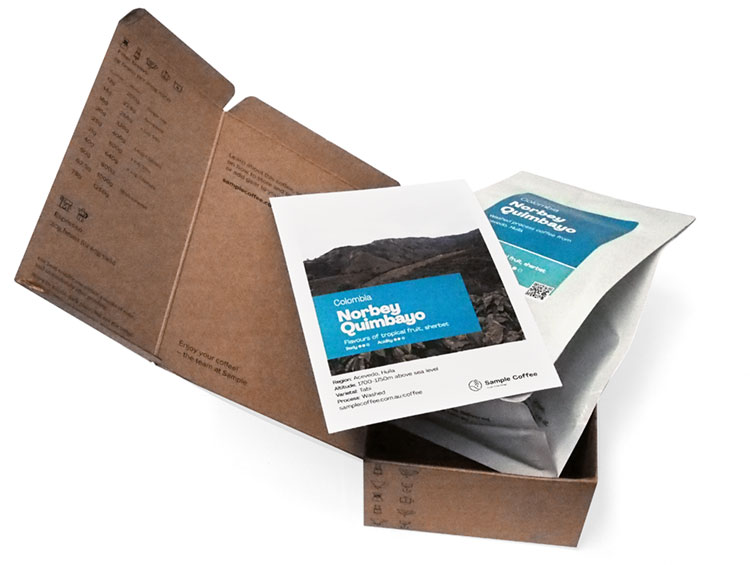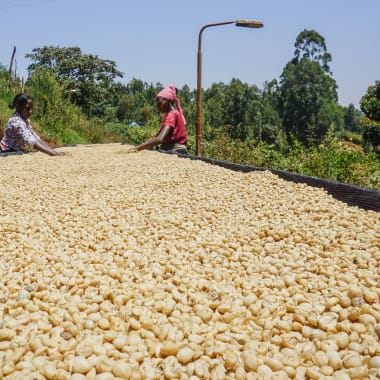-
Producer
-
Jabanto Producers
-
Country
- Ethiopia
-
Region
-
Kochere
-
Altitude
-
2000m above sea level
-
Variety
-
Process
-
Importer
-
Condesa Co.Lab
-
Body
-
Light
-
Acidity
-
Bright
-
Tasting notes
-
Lemongrass, raspberry and milk tea
-
Roast style
Ethiopia
Jabanto Producers
Anaerobic WashedThe Jabanto group produces different coffee types: regional, village and single farmer/variety lots. In this anaerobic lot we taste lemongrass, raspberry and milk tea
This coffee makes it again to the VS line-up for obvious reasons: a perfect execution, a complex fermentation process and a delectable cup presence. Very Special indeed.
VERY SPECIAL
Jabanto anaerobic washed was featured for the first time in our VS delivery for December 2021—just over a year ago. We’ve selected it again because it’s still an impeccable coffee and serves as a great tasting exercise when comparing it to Aricha, shared just a few weeks ago and which flavour may still be alive in your mind.
Both lots have gone through an anaerobic fermentation process. However, they’ve been approached differently: Aricha, an anaerobic natural (a.k.a. carbonic maceration), was wild, crazy, and loud; Jabanto, an anaerobic washed, is modest, contained and classy, yet still somewhat reminding us of ripe fruit.
Both are very distinct, very delicious, and Very Special.
BISHARI VARIETAL
After a devastating coffee-berry disease epidemic in the 60s, the Jimma Agricultural Research Center (JARC) started a research project to identify endemic, regional Heirloom varietals. The goal was to catalogue the diversity of Ethiopia’s arabica coffee genetics according to their performance, resilience, yield and other important properties. It would also build a specimen bank to use within the farming community according to the local circumstances.
Around Bishari, a small village in the southwestern region, many coffee trees seemed to perform well against disease, produce a decent yield and deliver interesting flavours. These were known for their smaller coffee leaves, smaller coffee cherries and beans, short canopy, and compact and persistent calyx. So, in 1974, the JARC collected seeds to use as breeders and classified them as Bishari.

Within this category, other sub-varietals share specific traits or genetics and are re-classified by their own name. For example, the Kurume varietal (known as such within the Guji area and as Kudhume within Yirgacheffe).
ANAEROBIC WASHED VS. ANAEROBIC NATURAL
Anaerobic means “without oxygen”. During this process, the coffee cherries ferment inside sealed vessels where the oxygen input is prevented or controlled. The low presence of this gas (it’s never really 0%, but close) limits the participation of microbes, facilitating a distinct range of bright and fruity hints.
The difference between the anaerobic washed and anaerobic natural processes lies in how the cherries go into the fermenting tank.
In the anaerobic natural, the cherries are placed along with their skin and pulp—whether crushed or intact. This method is technically the same as carbonic maceration, but different importers and producers will call it differently according to their conventions.
In the anaerobic washed, the cherries are placed without their skin and pulp—the stage of removing them is commonly known as depulping.
DEEP IN THE DETAILS
After the cherries have been picked and sorted, they are pulped (leaving their mucilage intact) and placed in the fermentation tanks for about 60 hours.
The Jabanto members built a few for this purpose. A valve on the side of the tank is connected to a thin hose, which helps remove any CO2 generated during fermentation. The other end of the hose is inserted into a bottle and submerged underwater, stopping any oxygen from coming into the sealed tank atmosphere. It sounds complex, but it’s relatively simple and easy to achieve; here’s a picture:

When the anaerobic fermentation process is finished, the beans go through a drying stage on raised bed drying for 6-8 days until their moisture level reaches 10.5%, similarly to traditional fully washed process methods. To maintain uniform drying among beans, the parchment coffee is set under the sun for two hours between 8:00 and 10:00 AM. During the hottest hours of the day, the parchment coffee is covered with nylon mesh and plastic between 11:00AM and 3:00 PM. Then, the parchment coffee is uncovered for another two hours between 3:00 PM-5:00 PM.
BREW, SHARE AND ENJOY
Time to brew and have a good time (beware of our new recommended window!). Check out any brewing notes below, and add your own—and don’t forget to ask us anything via email/Instagram. Enjoy!
All the images and information about this coffee and its producers have been kindly shared by the importer, Condesa CoLab, and edited by us, Sample Coffee (unless linked to or credited otherwise).
Learn everything about this coffee:
Ethical, traceable sourcing
This page has all the sourcing information (variety, process, region, story, importer, and more) that our importers share with us, and give us permission to use.
The transparency helps us talk confidently about the quality and background of our product, and it helps you know exactly what you’re buying.
Learn more:
Coffee page transparency legend
Our coffee philosophy
Our business approach
Fresh harvest coffee
We only source and roast coffee from each country’s latest harvest season (so the green coffee is never older than 1 year from the time of picking, processing and packing). This ensures the sensory qualities are always at their peak and unaffected by excessive ageing.
Roasted for espresso and filter (best enjoyed black)
Roast style: omni. Omni roasts are designed to brew and taste great both as espresso and filter. Our omni single origins generally sit on Agtron values in the ~70-60 value range. So, technically, they are somewhere in the lighter side of the medium spectrum.
Designed for espresso and filter brewing. Best enjoyed black.
Learn more:
Our Loring Kestrel S35 roaster
Our roasting style and approach
Best brewed within days 15-49 post-roast
The ‘fresh is best’ saying doesn’t apply to coffee (contrary to popular belief). Waiting before opening and brewing your bag of whole coffee beans helps develop peak flavour and acidity.
But heads up: if you buy pre-ground coffee, brew it as soon as possible.
Learn more:
Our recommended brewing window
Try our custom brewing recipes
Our recipes and ratios are tailored to our coffee sourcing and roasting styles, bringing the best flavour and feel out of each coffee.
For pour over, immersion, and other filter brewing styles, check our brew guides.
For our espresso single origins, we recommend a coffee:yield ratio of 1:3:
- Dose: 20g ground coffee
- Yield: 60g espresso
- Total brew time: ~24-28 seconds
This is just a starting point! We encourage you to experiment, taste, and adjust to find the recipe that you enjoy the most.
Learn more:
Our espresso brew guide (single origin)
Brewing ratio calculator
Packaging and sustainability
- Bags: ABA-certified home compostable (AS 5810-2010)
- Labels: recyclable
- Valves (only on +250g bags): general waste
- Box and tape (online orders): recyclable
Learn more:
Our packaging
The location
Coffee from Ethiopia
Seen as the birthplace of domesticated coffee, there are not many more exciting times at the Sample warehouse as when our fresh Ethiopian lots arrive. Legend says it’s our favourite origin…
The Kochere region of Ethiopia
Farm processes
Anaerobic Washed process
Machines are used to remove the flesh from the coffee cherry before being fermented in water, washed again, and finally sun dried. This process tends to result in more distinct, cleaner flavours.

Subscribe to a world of coffee
Discover a new single origin coffee from Sample every 1-5 weeks with no delivery fees.
No up-front purchase, and you can pause, cancel, or change plans at any time.
Available to order online this week:

Nicaragua Guillermo Montenegro
Flavours of plum, nectarine, shortbread
Body Acidity
Washed Caturra
March 2025 harvest
Roasted omni for filter and espresso
Nicaragua Guillermo Montenegro online
Kenya Karindundu Aa
Flavours of orange marmalade, grapefruit, Yunnan red tea
Body Acidity
Washed Batian, SL28, SL34, Ruiru 11
Roasted omni for filter and espresso
Kenya Karindundu Aa online
Ethiopia Bekele Gemeda
Flavours of mandarin, white peach, mango
Body Acidity
Washed Ethiopian Heirloom
November 2024 harvest
Roasted omni for filter and espresso
Ethiopia Bekele Gemeda online
Ethiopia Girma Sintayehu Honey
Flavours of apricot, mango, coconut, pineapple
Body Acidity
Honey 75227, Wolisho
February 2025 harvest
Roasted omni for filter and espresso
Ethiopia Girma Sintayehu Honey online